By Douglas Bullis
Douglas Bullis has lived all over the world in search of perfect skies. He finally retired in the arid Karoo highlands of South Africa, one of the three or four darkest regions in the world. After a forty-year career writing books about business, world cultures, art, and fashion designers, he discovered there’s a left side to the brain, and he’s been writing about astronomy ever since.
Who doesn’t dream of discovering that a forlorn princess pines away in a forgotten castle for a handsome hero to come to her rescue and take her away to that dream kingdom far, far away? And if the damsel is a forgotten historic 8-inch refractor doomed to the scrap heap by the pitiless hand of time and money, it becomes a fairy tale for astronomy buffs that even Disney couldn’t better.

And of course, the hero arrives riding a neighing charger (cleverly disguised as an Airbus 380), rescues the forsaken beauty, and they live happily ever after, at least between twilight and dawn. It sounds too good to come true.
But in Port Elizabeth, South Africa, it did come true.
Let’s start with the damsel (Figure 1): Her measurements wouldn’t make the beauty-pageant news. But at 102 inches tall, 16 inches wide, and 63 inches from stem to stern, she is as comely as any astronomer could wish. And who but an astronomer would delight in a shoe size of 38 inches with a two-inch cast iron sole? With shoes like that, you only need one, yet on a lass of 126 years, it looked just right. The best compliment ever paid to her was that she was built like a two-ton Swiss watch.
She really was Astronomy Technology Yesterday – 1891 to be exact. She represented the pinnacle of astronomical optics, mechanics, and instrumentation available to the (very) deep-pocketed amateur astronomer of the Belle
Epoque era between 1880 and 1914 (Figure 2).
The Cooke catalog’s title page conveys no real sense of what a true professional-level turn-of-the-century “Gentleman’s observatory” actually looked like if one were to step into the past and pay a call. Then one day in February 2015, this author and a couple of other South African amateur astronomers walked through the door of an unpromising dark-gray building and beheld a sight that could as easily been seen in February 1885 or even 1915. The huge mechanical device before us was both a bewonderment and disheartening. (See these Flickr pages: https://www.flickr.com/photos/130932591@N08/albums/72157659849343183 for the full image set taken on that visit.)
But as we got over the feeling we’d walked into a time warp, it dawned on us that hidden inside the down-at-the-heels building was a double-door multi-shelved cabinet of original brass and glass equipment that had lain practically unused since the 1950s. The Pepos Observatory was so crammed with 1890s technology that we concluded nothing like it had been assembled intact in one place since the 1910s. To wit:
- 8-inch (203mm) f/15.1 (3048 mm f.l.) Fraunhofer objective.
- Cast-iron pier and German equatorial mount with gearing for lunar, solar, and sidereal rates, plus manual slewing capability.
- Working clock drive in glass-windowed metal enclosure, running time approximately eight hours.
- Low-dispersion stellar spectroscope in custom mahogany box (Figure 3).
- High-dispersion solar spectroscope in custom mahogany box.
- Filar micrometer in custom mahogany box (Figure 5).
- 5-inch diameter Ronchi grating.
- Astronomical protractor in custom mahogany box.
- Spirit level in custom mahogany box.
- One of the Troughton & Simms 1839, 42-mm portable transit telescopes dispatched by the British Royal Navy in connection with the Venus transit of 1882. (This effort was intended to establish an accurate time base of geographical locations so that, although the Sun might never set on the British Empire, the Royal Navy would be aware of where exactly in the sky that Sun might be at any given hour anywhere in the world.)
- Six original Ottway Huygens eyepieces (draw-tube diameter 30.06-mm or 1.2 inches) in a wood box (Figure 4).
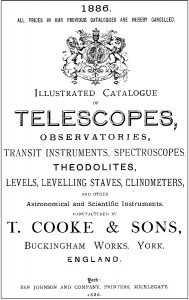
The first glimpse was enough to make any astronomer’s heart soar. The second glance was enough to clip that soar’s wings. This magnificent collection was facing the worst end an astronomy devotee could imagine: Her exquisite lens in a musty museum; all the rest of that gorgeous workmanship melted down as scrap.
The dwindling membership of the Port Elizabeth People’s Observatory Society was at wit’s end with a seemingly insoluble dilemma – the telescope was too valuable to sell, too big to move, and too expensive to restore.
A diligent search undertaken by the country’s professional body, the Astronomy Association of South Africa, turned up no person or organization in South Africa with the financial base, technical expertise, and desire to restore such a complex piece of equipment. Pepos was the most beautiful albatross the spirit of astronomy could devise.
Then came the really big problem: Where do you put one of these with some assurance that the place won’t be light-polluted out of existence in a decade or so?
Rehabbing a telescope of the Cooke’s antiquity and deteriorating condition is much more than a gallon of Brasso and a lot of elbow grease. Brass and iron came very cheaply in 1800s Britain, and it showed. Astounding masses of brass were foundry-cast and precision-machined in those days, yet each individual piece was unique.
A lathe operator might turn out individual screws for hours by hand, then be assigned to gears, or handles, or knurled focuser knobs. Parts matched yesterday by lap-grinding might not thread into today’s threads. Over their 125 years, the brass surfaces had become begrimed with dust mixed with sea humidity.
Thin films of recent hydrocarbon soot and rubber tire particles lay atop a crust of amorphous corrosion. The original black-painted OTA and mount housings had been repainted with a dense lead-based gray coating, which had so badly crystallized that cracking the seal of screws sprayed splintery shards in our faces and all over our hands; some simply refused to budge, even with a torch.

Decades-old grease had oxidized so badly that it had lost its lubrication and transformed into a thick, sticky gum more like tapioca in Jell-O than emollient grease. The hand-machined screws, nuts, bolts, braces, and brackets required ultra-thin-blade screwdrivers available only from specialized hardware purveyors (at $49.99 for a set of 6!). The thread diameters, pitches, and face angles of 1891 relied on a now abandoned standard called the “RAS thread,” which corresponded to no other system in use today – Whitworth, Imperial, SAE, or Metric.
Luckily, the glass of the objective showed no chips or surface scratches visible to the eye. There were small patches of seaweed-like hyphae mold that could be easily removed with alcohol. Yet even with this modest glimmer of hope, the overall picture was summed in a word: Bleak. No one in South Africa could undertake such a demanding – and costly – task. One look at this website, http://www.ulo.ucl.ac.uk/telescopes/fry/ , tells us why.
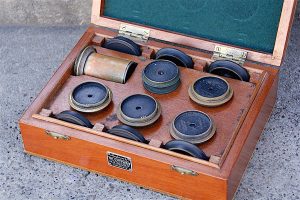
give away the tale before the telling, Pepos was put up for international auction. To the rescue charged a hero named Daniel Mobati, a telescope restorer living in Oakland, California. His modern weaponry is screwdrivers and ratchet-wrenches in lieu of the more traditional dragon-slaying gear.
He responded to Pepos’s plight with a proposition no damsel could refuse: “I will take you to my most beautiful land of the Napa Valley, and there I will build for you a magnificent observatory, where the world will come to see your stars. Your friends will be the Clarks, the Grubbs, the Brashears, and a sweet old uncle named Dollond. You will live happily ever after making the world as happy as you.”
An Inauspicious Beginning
The Port Elizabeth Cooke went by the name of Pepos, but it wasn’t always thus. She started life as the bottom of a broken whiskey tumbler found on a rubbish tip by a curious young man. He thought she might be perfect for his grand dream: A telescope to look at the stars and planets and moon.

The young man was Thomas Cooke, a cobbler’s lad born March 8th, 1807, in the Yorkshire village of Allerthorpe. His formal education was two years in an elementary school before his father summoned him to the workbench. Thomas’ interests lay elsewhere. Inspired by the exploits of his namesake – Captain James Cook – young Thomas wanted to explore.
He taught himself mathematics and navigation. At the age of 17 he was all set for a life at sea, but was dissuaded by a fretful mother to instead take up teaching at a village school. From 1829–1836, he taught local youngsters. He used his spare time to advance his studies in math, optics, and mechanics.
Around 1832, Cooke made himself a small telescope from the bottom of a broken whiskey tumbler. Its tube was a sheet of tin. The telescope worked tolerably enough that it inspired local Yorkshiremen to “peer at the planets.”
Thomas showed it to John Phillips, curator of the Yorkshire Museum and a member of the British Association for the Advancement of Science. Phillips encouraged Thomas to think bigger. At the age of 28, he made a 4.5-inch telescope using hard-to-get optical crown and flint and brass bought from his savings. He made it entirely by himself using knowledge he picked up in libraries.
The telescope introduced Cooke to the much larger world of the British scientific community. Thomas was encouraged to embark on a full-time career as an instrument maker. He borrowed £100 from his wife’s uncle and rented premises in York. His wife Hannah worked in the shop and took in lodgers to help with the rent. He built his own screw-cutting lathe and lens grinding and polishing machines.
Refractors of 4 or 5 inches were a rarity at the time and quite costly by our standards. His 4.5-inch was so optically successful that Cooke promptly pushed the boundary. In 1851, he built a 7.5-inch equatorial for Hugh Pattinson of Newcastle. Pattinson was a friend of Isaac Fletcher, a well-known astronomer who recommended Cooke to Sir George Airy, the Astronomer Royal.
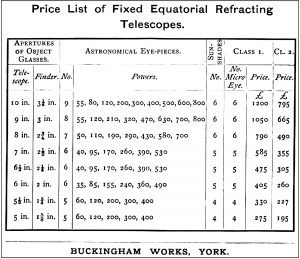
Young Mr. Cooke may have been a neophyte to the world of astronomy, but he was no babe in the woods in the fundamental requirement of modern manufacture: marketing. Witness the1886 Cooke catalog, shown in Figure 6.
To reduce the bottlenecks that hinder consistent product quality – unreliable suppliers and uncertain quality control – Thomas built his factory based on end-to-end flow-path production. Half a century later, Henry Ford called the same method an “assembly line.” Cold-rolled sheet iron, billet brass, and glass blanks arrived at one end. A diversified, self-consistent, high-quality product line emerged from the other.
Cooke perfected two virtues inherent in end-to-end thinking. One was standardizing the design of large assemblies, such as GEM mountings and gear-sets, which lowered unit costs. They were also scalable. One mount design could be used for many different optical tubes. Cooke’s no-frills 1850s German mount could carry OTAs with 6-inch to 12-inch f/15 objectives.
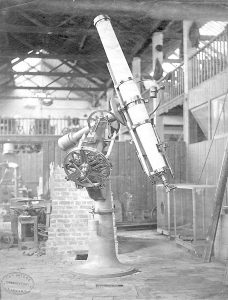
A less-visible cost-control benefit was just-in-time control over small parts. A small-parts machinist would mill as many screws and bolts as the current pipeline demanded, then turn to gear cutting until the bolts ran low. The flip-side was slight mismatches in parts used in each successive telescope. Cooke also standardized the big bits: The 8-inch scope was over-mounted in the Port Elizabeth instrument, but not if the same mount held a 10-inch or 12-inch scope – precisely what Cooke intended.
Nipping at Cooke’s heels was Thomas Grubb of Ireland, likewise no loafer when it came to product proliferation led by quality control. He started off as a billiard table maker and ended up producing the largest telescopes of his time. By 1860, both names were a byword for precision. Cooke’s 1886 catalog listed five full pages of spectroscopes alone, comprising 101 different models. The United States was no slowpoke in producing its own rising stars, the forerunner Henry Fitz, trailed closely by Alvan Clark and John Brashear.
These telescope makers’ embrace of product diversity may sound like the Japanese SLR camera industry in the 1970s, but in fact, the late 1800s manufacturers were following an already well-trod path. In the 1770s John and Peter Dollond produced somewhat standardized telescopes of many varieties and prices, plus sextants, octants, theodolites, and surveying instruments. So did Robert-Aglaé Cauchoix and Georg Merz & Sons of France; and Joseph von Fraunhofer and Georg Friedrich von Reichenbach of Germany.
All of these were legatees of the European Enlightenment’s emphasis on logic over tradition. Not to mention economics above ecclesiastics – the likes of Fraunhofer, Cooke, and Grubb were not so foolish as to forget an affluent merchant class buys more opera glasses than a lordly ruling class.
The 19th century has been called “The era of the Grand Amateurs.” Then as now, nonprofessionals made significant contributions to the science. In the 1860s, John Birmingham of County Galway, Ireland used a 4.5-inch Cooke refractor to study “red stars.” Birmingham logged 658 of them. This was long before the Hertzprung-Russell Diagram came along to show that many stellar processes could be bundled into the term “red.” The science of astronomy traced Birmingham’s beloved “garnet hued gems” to the opacity of carbon ash convected to the surface of helium core-burning stars – a process is unromantically described as “third dredge up.”

Export markets were at the heart of colonial economic thinking. The Venus transits of 1882 and 1894 provided a ready excuse to ship small portable solar transits (Figure 8) to the nethermost islets the Empire to draw the time zones so the Empire’s Sun would never set. Transits were soon followed by theodolites and surveying chains to map the terrain. A few of these were literally set up on a beach table above high tide on a remote Pacific island.
The right telescope at the right time can redirect a career. In Bankura, India, one Chandrasekhar Venkata Raman used his 5-inch Cooke refractor to observe Saturn. The aspiring young mathematician wrote, “Not only was the Crepe ring an easy object, but for nearly one hour while the definition was perfect, I made out Encke’s marking in the A ring and held it steadily for practically the whole period.” Chandrasekhar reset his compass toward astrophysics. Early in the 20th century, he mathematically modeled the energy physics of Type 1A supernovae and won the Nobel Prize in 1930.
Hobby Becomes Science
Cooke’s growing mastery of telescope making coincided with the merger of visual astronomy with exact science. In the late 1850s, Gustav Kirchoff, Robert Bunsen and William Huggins combined theory with observation to define the relations between chemistry, temperature, and the emission and absorption of light in gases. No sooner had the chemical composition of the Sun become known than the Cooke company added spectrometers (Figure 9) to their lengthening list of optical micrometers,
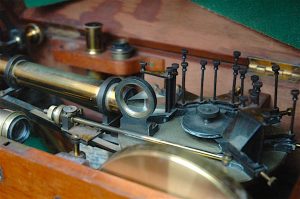
transits, and theodolites.
Most of the affluent gentry who bought telescopes used them to map planetary features and systematize the measurements of double stars. Others, though, found new hay to winnow. In 1858, William Huggins had acquired an 8-inch object lens by the famed American optician Alvan Clark, paying some £200 for it (equivalent to US$ 28,120 at today’s rates). He then commissioned Thomas Cooke & Sons build a tube, mounting, and spectroscope for his intended use, stellar spectroscopy.
The fact that starlight could be separated into constituent hues was known as far back as Isaac Newton. Only in the first few decades of the 19th century did William Wollaston and Gustav Kirchoff notice that the dark absorption lines in the Sun’s spectra corresponded exactly with the bright emission lines recorded by Robert Bunsen in the spectra of specific chemical elements heated to incandescence. When William Huggins learned this, he constructed a modest two-prism spectroscope to observe the emission of planets and nebulae to learn what they were made of. Its dispersion was good enough to show that the Moon’s spectrum contained the same absorption features as the Sun.
But there also were absorption bands of iron, manganese, and silicate compounds, which did not exist in molecular form on the Sun. He deduced that the Moon was made of the same stuff as the Earth, but the Earth added a few touches of its own. Today such “telluric” bands are deducted when they appear in stellar and nebular spectra. By 1864 Huggins could summarize one of astronomy’s fundamental theorems: “The entire universe is one chemistry.”
Not content to rest on that laurel, in 1897, Huggins directed his Cooke spectroscope on a planetary nebula and on the Great Orion Nebula. He found not absorption or emission lines, but a continuous spectrum. “The riddle of the nebula is solved,” he wrote. “They are not an aggregate of stars, but a luminous gas blending many spectra.” He concluded exuberantly, “So unexpected and important are the results of spectrum analysis of the heavens, this method maybe said to have created a new and distinct branch of astronomical science.”
Mr. Bently Makes Good
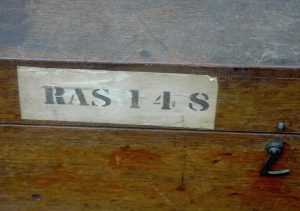
When the owner of this fine 1891, 8-inch Cooke refractor passed away in 1911, the Cooke was bequeathed to the Royal Astronomical Society “to put it to good use.” (See Figure 10) The RAS catalogued it as Inventory Item RAS 148 on page 229 of the Royal Astronomical Society Instrument Collection 1927–1985 (Q Jl R. Astr Soc, 1986, 27, 212–236). ( 1986QJRAS..27..212H ) There it might yet be mouldering away, but for the interest of a tiny group of eight aspiring stargazers from South Africa.
Unless it happens to be your birth year, 1947 is not noted for much. The word “computer” was coined in April that year to describe an electronic digital computational machine. In June, an American aviator named Kenneth Arnold made the first widely reported sighting of an unusual object flying near his plane. Unhappily for the cause of exactitude in science, it looked like a flying saucer. Measurement and misperception have competed for our allegiance ever since.
In the somewhat sleepy postwar port of Port Elizabeth, South Africa, a Mr. J Bently had developed a keen interest in astronomy. He was once a fisher who navigated by the stars. When he looked up at night in those LP-free years, there was a lot up there to marvel. The Milky Way was so bright it cast the shadow of his hand on a white surface. On 28 May, 1947, Bently gathered twelve celestially minded colleagues to form an observatory society.
Mr. Bently’s group was realistic about their ambitions: They borrowed a 4-inch refractor and an epidiascope used to project images of book pages onto a wall. That set a South African precedent that a proper observatory must have a lecture room in the same facility. Bently made inquiries at the Cape Observatory and learned that a large Cooke Refractor in storage at the Royal Astronomical Society in Britain might be available. The asking price was a pulse-quickening £1,200 (approx. US$40,800 today).

By the standards of the time, that was a bargain. With astrophotography in the 1880s, the sands had shifted in the swirling tides of astronomy economics. The cost-vs-science yield inherent in permanent images and large-surface reflecting telescopes had turned most gentleman astronomers into gentleman racing horse owners. The word “astronomy” was understood to mean a fully equipped and staffed professional observatory, not a ATMer in the back yard, no matter how exotic their equipment.
Even so, the numbers of middle-class backyarders ascended dramatically, particularly in America, where DIY is as deeply ingrained as owning an automobile. The Second World War devastated global science budgets; after all, entire nations needed rebuilding before observatories might be contemplated.
The cheerful enthusiasts of Port Elizabeth were affluent enough to pursue their love of the stars. Like so many early-adopters, they relied on hand-me-downs. They initiated a public fund-raising drive and within a year had garnered enough private and public funds to order the RAS Cooke. The name “Port Elizabeth Peoples Observatory Society” (Pepos) is a fitting amalgam in honor of so diverse an array of open wallets.
Their glorious new Cooke refractor arrived in two enormous crates in mid-1949. The world was large and getting larger. That same month the packet HMS Pamir was the last commercial sailing ship to round Cape Horn under sail alone. Fred Hoyle coined the term “Big Bang.” The City of Port Elizabeth generously opened its purse to the tune of £2,000 to build a roll-off-roof abode for their pride and joy. By June 1953, PEPOS Committee deemed the equipment, observatory and personnel had been finely honed enough to open the telescope to the scrutiny of all South Africa.
Shown here is the text from the article that appeared in THE HERALD NEWSPAPER in Port Elizabeth, Eastern Cape June 29 1953:
Public Can Peer at the Planets Through City’s New Telescope
The only large astronomical telescope to be set up solely for the public use in South Africa is to be opened to townspeople and visitors to Port Elizabeth on Wednesday night.
Officers of the Port Elizabeth centre announced yesterday that, weather permitting, members of the Society would be in attendance every Wednesday night, starting this week, to enable small parties of interested people to look at the planets. The telescope is the only large professional telescope to be set up solely for the benefit of the public in South Africa.
Only one month earlier, on May 3, the first commercial jet flight service commenced between South Africa and Britain began with the arrival of a De Havilland Comet with 36 passengers at Johannesburg.
During the opening-day festivities, Mr Bently addressed the visitors: “It is my sincerest hope that South African amateur astronomy might one day produce its own William Herschel.” Bently may well have had in mind Lindsay Atkins Eddie (1845 – 1913) a native-born amateur astronomer from Grahamstown, who observed 21 comets and the Mercury transit of 1894. His drawings of the planet Mars were highly acclaimed in the world of planetary astronomers.
South African astronomy had roots as far back as the eighteenth century visit of Nicolas-Louis de La Caille to chart the positions of the southern stars. The 19th and 20th centuries brought William Herschel and his 18-inch speculum reflector, the 74-inch Radcliffe reflector in Pretoria, and the Cape Observatory’s fanfare of instruments, which included the renowned 24-inch McClean Refractor (now gleamingly restored to its original condition).
Illustrious names in the annals of astronomy either were born or spent considerable portions of their lives in South Africa. Their papers peppered the professional literature. The double stars which so preoccupied gentlemen astronomers of the late 19th century were not forgotten. Willem Hendrik van den Bos discovered thousands of double stars and recorded tens of thousands of micrometer measurements of such stars, calculating the orbits of a number of binary stars.
At the other end of the megaparsec scale, Anthony Patrick (Tony) Fairall specialized in the large-scale structure of the Universe revealed in filaments and voids. The QSO Fairall 9 is so important that it is still cited in Magellanic Cloud studies. William Cousins, South African by birth, devoted himself so assiduously to improving photometric methods that his UBVRI color photometric system standardized spectral colors used to determine the metallicities of stars and nebulae; his work was a major factor in turning the static Hertzsprung-Russell Diagram into today’s Colour-Magnitude Diagrams (CMD).
When the Cooke telescope was offloaded onto a Port Elizabeth dock in 1948, South Africa’s leading astronomer was Andrew David Thackeray (1910 – 1978). He directed the Radcliffe Observatory for 23 years, specializing in stellar spectroscopy. As Port Elizabethan eyes trained on the southern skies through the Cooke telescope for the first time in 1950, Thackary published his first studies of dense, inky dark “globules” that he had spotted in the Eta Carinae complex. He suggested that the interplay of supersonic turbulence, magnetohydrodynamic forces, and gravitation wrote the rules of star formation in chaotic, hot gas structures. This was the first time so many complex physical forces had been discerned at work in one group of very small objects.
Not to be outdone by his own feats, in 1952 Thackary presented studies of variable stars in the Magellanic Clouds which suggested that the age and size of the universe as then understood was in fact too young and too small by half.
All this would have swelled the chest of Sir David Gill, HM Astronomer at the Cape from 1879–1907. Gill was a masterful administrator and visionary. His vision of bringing forefront science to South Africa set the direction of South African astronomy for decades. His seedling bore spectacular fruit when the Astronomical Society of South Africa was appointed the monumental task of overseeing the Square Kilometer Array (SKA), which will be the largest radio astronomy centre in the world.
Not farewell. Fare forward
At its peak in the 1980s, the PEPOS sported 81 members. But starting in the 2000s, there was an inexorable decline. Aging was part of it, but more so was light pollution. Once sited in a solitudinous meadow, the Port Elizabeth observatory is now ringed with suburbs ten miles in every direction. Fast food restaurants and mini malls clog the road only a block away. The same thing happened to the observatories in Cape Town and Bleomfontain. But while the professional community had the resources to move their equipment to an excellent remote site in Sutherland, not so fortunate was Pepos in Port Elizabeth.
The historic Cooke telescope was less and less visited. The Port Elizabeth Astronomical Society faced the vexing problem of what to do with a deteriorating telescope in a location with dismal skies. Some members were all for selling it off as scrap metal and be done with it. Wiser heads prevailed.
The most far-sighted was Nielen Schaefer, a long-standing Society member and devoted observer. Mr. Schaefer enlisted a small group of individuals to seek a solution – Ms Kate Cobbing, the professional astrophysicist Case Rijsdijk, Rhodes University professor Marc Schafer, and this author. Initial attempts to find a home for it in South Africa found no one with the experience, wherewithal, and desire to restore such a complex piece of equipment.
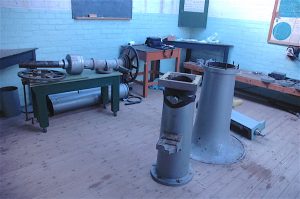
Then this author came across the Antique Telescope Society, a worldwide forum of some 883 members whose great avocation in life is to put back into use historically priceless astronomy equipment. After a flurry of correspondence with the ATS President Bart Fried, a plan gelled to set up an international auction designed to attract the most qualified historical instrument restorers in the world. The auction took a month. The applicants were few but they presented collecting histories that included prestigious names like Clark, Brashear, Fitz, Fraunhofer, Grubb, and of course, Cooke.
On 28 October, 2015, PEPOS announced that the highest bidder for the 1890s Cooke was Daniel Mobati of Oakland, California. Mr. Mobati was chosen as much for his intentions as for the amount of his winning bid. In his own words: “It would indeed an honor to be the next custodian of this observatory. My plans include restoration and preservation of all the instruments which will be housed on an observatory in the San Francisco Bay Area. The specific location will be in Napa Valley, in the heart of the Wine Country. I hope it will be instrumental in providing access to the interested public (specially the youth generation) with the goal of educating and sparking an interest in the history and the science of Astronomy.”

By the end of 2015, Nielen Schaefer and this author had stripped the Cooke telescope down to crate-able size pieces ready for shipping to the USA (Figure 13). In July 2016, the magnificent telescope was loaded into a container in Port Elizabeth. One month later it was offloaded from a semi-trailer truck in Mr. Mobati’s driveway.
This story couldn’t have been told without acknowledging the role of amateur astronomy in the USA. The spectacular success story of amateur astronomy today had its roots in American middle-class affluence after World War II. To the world at large, only in 1957, with the Moonwatch Program, did backyarders become Everyman astronomers.
Throughout the last half of the 20th century and well into this one, science has delivered more betterment for humanity than politicians. Now in the mid-2010s, the simultaneous achievement of generalized wealth and the

technology of mass production has given us an astronomy world no one could have dreamed until now.
Where once there was a Cooke, a Grubb, a Clark, a Brashear, or a Merz to choose from – all of them prohibitively dear to the average buyer – today’s lover of the skies has a veritable bonanza of product catalogs to choose from at prices for every budget. Not to mention the classifieds, the clubs, the star parties, the online forums, and thousands of astrophotogaphers churning out images that would have astonished Palomar astronomers just a decade ago.
Mr. Mobati summed up this whole tale better than anyone: “Why look backwards for a Golden Age when we live in one?”
###
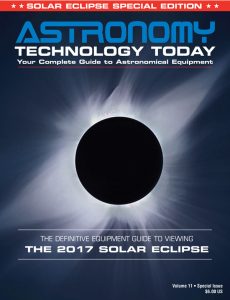 The Astronomy Technology Today editorial staff would like to take this opportunity to remind you of the availability of our Solar eclipse equipment guide – The Definitive Equipment Guide to the 2017 Solar Eclipse. Our goal with the 40 page publication is to provide an easy-to-consume introduction to the technological options for viewing and imaging the Great Solar Eclipse. We cover the gamut of options available including building you own solar viewer, solar glasses, smart phones, DSLR cameras, using astronomy telescopes, solar telescopes, using binoculars, solar filters (including a DYI filter option), CCD astro cameras, astro video cameras, webcams and much more. You can view the guide on our website here – its free and there is no requirement to sign up to read the guide.
The Astronomy Technology Today editorial staff would like to take this opportunity to remind you of the availability of our Solar eclipse equipment guide – The Definitive Equipment Guide to the 2017 Solar Eclipse. Our goal with the 40 page publication is to provide an easy-to-consume introduction to the technological options for viewing and imaging the Great Solar Eclipse. We cover the gamut of options available including building you own solar viewer, solar glasses, smart phones, DSLR cameras, using astronomy telescopes, solar telescopes, using binoculars, solar filters (including a DYI filter option), CCD astro cameras, astro video cameras, webcams and much more. You can view the guide on our website here – its free and there is no requirement to sign up to read the guide.

